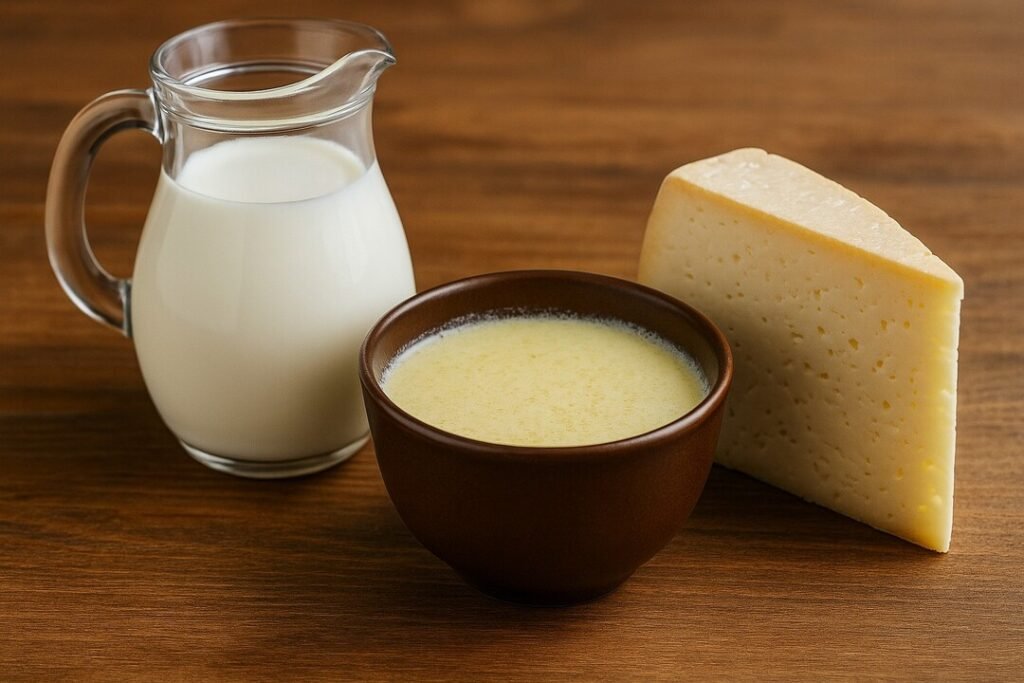In recent years, debates around natural and traditional foods have become louder than ever. Among the most controversial topics is the consumption of raw milk, colostrum, and other unpasteurized foods. Advocates claim that these foods are nutritionally superior, offering probiotics, enzymes, and immune-boosting compounds destroyed by modern processing. Critics, on the other hand, point to the undeniable risks: bacterial contamination, foodborne illness, and public health outbreaks.
The conversation isn’t entirely new. For centuries, humans consumed milk straight from the cow or goat, fermented it into cheese or yogurt, and drank colostrum for its supposed healing properties. Pasteurization—a process of heating milk to kill harmful bacteria—was only introduced in the late 19th century to combat diseases like tuberculosis and typhoid. Today, with food safety standards high in most countries, some argue pasteurization is an outdated precaution, while others see it as a non-negotiable public health safeguard.
So where does the truth lie? Are raw milk and colostrum hidden superfoods unfairly maligned, or risky relics of the past? In this article, we’ll explore the science, benefits, risks, and expert opinions on unpasteurized foods—helping you make an informed decision about what ends up on your plate.
What is Raw Milk?
Raw milk is milk from cows, goats, or sheep that has not been pasteurized to kill harmful bacteria. It may also be unhomogenized, meaning the fat rises to the top.
Historical Context
For much of human history, raw milk was the only option. Families milked their animals daily, consumed the milk quickly, or preserved it through fermentation. But in urban areas with crowded dairies and poor hygiene, raw milk was a leading source of deadly outbreaks in the 1800s. Pasteurization—introduced by Louis Pasteur—dramatically reduced illness and became standard worldwide.
Modern Use
Today, raw milk is illegal for retail sale in many U.S. states and countries. Where permitted, it is often marketed as a premium, artisanal product, sold directly from farms with strict hygiene practices. Consumers are often drawn to its “natural” appeal, richer taste, and belief in superior nutrition.
What is Colostrum?
Colostrum is the first milk produced by mammals immediately after giving birth. Unlike regular milk, colostrum is thicker, richer in proteins, and packed with antibodies. In both animals and humans, it serves as the newborn’s first line of immune defense.
Nutritional Profile
- Immunoglobulins (antibodies): Strengthen the immune system.
- Lactoferrin: An iron-binding protein with antimicrobial properties.
- Growth factors: Aid in gut development and repair.
- High protein, low fat and sugar: Compared to mature milk.
Human Use
Colostrum supplements—usually bovine (cow) colostrum—are marketed for gut health, athletic performance, and immunity. Some traditional cultures consume it fresh, considering it a delicacy or medicinal food.
Claimed Benefits of Raw Milk & Colostrum
1. Rich in Natural Enzymes
Proponents argue that pasteurization destroys enzymes like lactase, which help digest lactose, making raw milk more tolerable for some lactose-intolerant individuals. However, scientific evidence is mixed.
2. Probiotic Potential
Raw milk contains naturally occurring bacteria, some of which may act as probiotics, supporting gut health. Pasteurization reduces microbial diversity, though fermented dairy like yogurt can restore probiotics.
3. Higher Nutrient Retention
Certain heat-sensitive vitamins (like vitamin C and B-complex) may be slightly reduced during pasteurization. Advocates suggest raw milk preserves more nutrients, though the differences are often small.
4. Immune-Boosting Compounds in Colostrum
Studies show bovine colostrum can reduce gut permeability (“leaky gut”), enhance immune defense, and support recovery in athletes.
5. Taste and Culinary Appeal
Fans of raw milk describe it as creamier and sweeter than pasteurized milk, with seasonal variations depending on the animal’s diet.
The Risks of Raw Milk & Unpasteurized Foods
1. Bacterial Contamination
The biggest concern is the risk of dangerous pathogens, including:
- E. coli
- Listeria monocytogenes
- Salmonella
- Campylobacter
These bacteria can cause severe illness, particularly in children, pregnant women, the elderly, and immunocompromised individuals. Outbreaks linked to raw milk still occur annually in the U.S. and Europe.
2. Foodborne Illness
Symptoms range from diarrhea and vomiting to kidney failure or miscarriage in severe cases. The CDC and FDA strongly warn against raw milk consumption.
3. Variability in Safety
Even the cleanest farms cannot guarantee pathogen-free milk. A single lapse in hygiene, contaminated equipment, or an infected cow can introduce dangerous bacteria.
4. Regulatory Concerns
Because raw milk sales are restricted in many areas, distribution often occurs outside traditional food safety oversight, raising further risks.
What Experts Say
Public Health Authorities
Organizations like the CDC, FDA, and World Health Organization emphasize that the risks of raw milk outweigh potential benefits. They point to the safety and consistency of pasteurized milk as a public health success story.
Nutrition Researchers
Many acknowledge that pasteurization slightly alters certain nutrients but argue the impact is negligible compared to the risk of foodborne illness. They also note that probiotics and enzymes can be obtained safely from fermented foods.
Advocates and Alternative Health Practitioners
Advocates believe raw milk and colostrum are misunderstood and unfairly demonized. They emphasize traditional diets, farm-fresh practices, and anecdotal reports of improved digestion or immunity.
Middle Ground
Some experts suggest that if consumers choose raw milk, it should only come from small farms with excellent hygiene, tested herds, and transparent practices. But even then, risk cannot be eliminated entirely.
The Case for Pasteurization
While sometimes seen as an unnecessary modern intrusion, pasteurization remains a cornerstone of food safety.
- Dramatically reduced milk-borne diseases since its adoption.
- Preserves most nutrients while eliminating harmful bacteria.
- Allows milk to be transported and stored safely in urban environments.
Alternatives and Compromises
1. Fermented Dairy
Yogurt, kefir, and aged cheeses—whether from raw or pasteurized milk—provide probiotics and enhanced digestibility. Fermentation offers some of the “benefits” raw milk drinkers seek, but with added safety when pasteurized bases are used.
2. Certified Raw Milk Programs
Some countries (like parts of Europe) allow regulated raw milk sales, requiring frequent bacterial testing and strict hygiene. Advocates argue this provides safer access.
3. Colostrum Supplements
Powdered bovine colostrum supplements are widely available and offer immune benefits without the risks of consuming raw liquid milk.
Balancing Tradition and Safety
The debate over raw milk and colostrum highlights a broader cultural question: how do we balance respect for traditional foods with modern scientific understanding? While raw milk may connect people to farming heritage, it’s important to remember that pasteurization was introduced for a reason—people were dying from milk-borne illnesses.
Still, the conversation around colostrum and unpasteurized foods invites a valuable reminder: not all modern processing is negative, but neither should tradition be dismissed outright. The challenge lies in weighing personal values, taste preferences, and risk tolerance against established evidence.
Frequently Asked Questions (FAQ)
Q1. Is raw milk more nutritious than pasteurized milk?
The differences are small. While pasteurization slightly reduces some heat-sensitive vitamins, the nutritional profiles are broadly similar.
Q2. Can raw milk help with lactose intolerance?
Some people report better tolerance, possibly due to enzymes, but scientific evidence is inconsistent. Lactose-free milk or fermented dairy is a safer option.
Q3. Is bovine colostrum safe for humans?
Yes, when processed properly. Supplements have shown benefits for gut health and immunity. However, raw colostrum carries similar bacterial risks as raw milk.
Q4. Who should avoid raw milk?
Children, pregnant women, the elderly, and immunocompromised individuals are at highest risk and should strictly avoid raw milk.
Q5. Are outbreaks from raw milk common?
Yes. Dozens of outbreaks occur annually in the U.S. alone, leading to hospitalizations. Pasteurization eliminates this risk.
Raw milk, colostrum, and other unpasteurized foods occupy a fascinating crossroads of tradition, nutrition, and safety. Advocates highlight their richness, enzymes, and immune-boosting compounds, while health authorities emphasize the serious risk of bacterial contamination.
For most people, the safest and most practical choice remains pasteurized dairy, supplemented with fermented products and, if desired, colostrum powders. Those who do choose raw milk should understand the risks fully and source it from farms with rigorous safety practices.
Ultimately, the debate is not simply about nutrients—it’s about values: balancing tradition, taste, health, and science. Whatever choice is made, it should be informed, cautious, and rooted in both personal conviction and public health awareness.





